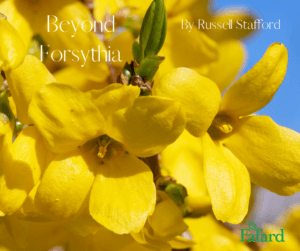
Forsythias are not the only shrubs that bloom bright yellow early in the year, despite being the only ones you’re likely see in your neighborhood or at your local garden center. Indeed, they are far from the earliest – or the best—such shrubs. Several other hardy shrub species not only produce sunny yellow flowers weeks or months before forsythias blossom, but also offer ornamental interest post-bloom (rather than reverting to an anonymous tangle of suckering stems, as forsythias do). Yet, because they flower before the gardening season is in full swing and are harder to propagate than forsythias, these superior alternatives are far less known in nurseries and gardens.
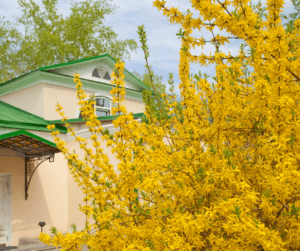
If you’ve ever puzzled over a “forsythia” that’s in full bloom in midwinter, chances are it’s actually a hybrid of Chinese witch-hazel (Hamamelis × intermedia). The earliest varieties open their ribbony blooms during mild weather in February or even January in zones 6 and warmer. These large, often V-shaped shrubs usually flower in yellow, but some varieties delve into redder parts of the spectrum. Numerous hybrid witch-hazel cultivars are available from a handful of gourmet mail-order nurseries, and all are worth trying. You’ll do just fine though with the relatively common ‘Arnold Promise’, which produces abundant golden-yellow flowers rather late in the witch-hazel season (February to March). One of the best of the non-yellow cultivars is the paprika-red ‘Diane’, which glows especially warmly when backlit by the winter sun. All witch-hazel flowers possess a delightful citrusy perfume, which carries on whatever mild breezes might be wafting. Their broad, bluntly toothed leaves go yellow or orange in fall.
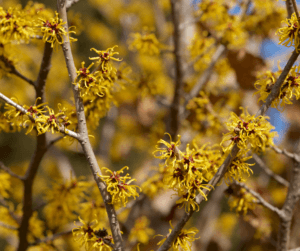
Offering rather smaller flowers than the Asian hybrids is the U.S. native Hamamelis vernalis, commonly known as Ozark witch-hazel. The yellow to violet blooms open as early as December, on densely branched plants that top out at 8 feet or so, rather than the 10-feet-plus of most Asian witch-hazel varieties. Ozark witch-hazel thus makes a splendid choice for hedging (unlike an unruly Forsythia!). For smaller gardens there’s the cultivar ‘Quasimodo’, which matures at around 5 feet tall and wide.
Then there’s the most widespread U.S.-native witch-hazel, Hamamelis virginiana. A fall-bloomer, it’s outside the scope of this article, but well worth incorporating in your garden. Most witch-hazels are hardy to USDA Zone 5.
As their common name suggests, winter-hazels (Corylopsis) resemble witch-hazels in several respects, particularly in the shape of their handsome foliage. This is not surprising, given that they’re also members of the witch-hazel family. Most mature as large shrubs of 8 to 10 feet or more, which dangle chains of yellow flowers from their branches a couple weeks before forsythias bloom. Buttercup winter-hazel (Corylopsis pauciflora), however, grows more compactly, forming tightly thicketing clumps of 4- to 6-foot tall stems. They’re elegantly adorned in late winter with clusters of sulfur-yellow blooms, with the leaves turning similar pale yellow hues in fall. This first-rate shrub is one of the most desirable subjects for USDA Zone 5b to 8 gardens, as is its hybrid ‘Winterthur’. Give your winter-hazel a site sheltered from hot sun and northwest winds, with an occasional top-dressing of Fafard Organic Compost to keep it extra-happy. They’re hardy to milder sectors of Zone 5.
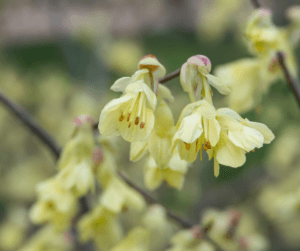
Another group of shrubs with very early blooms are the cornelian cherries, best known in gardens in the form of Cornus mas. Maturing at 12 or more feet tall, this Zone-5-hardy member of the dogwood tribe also can be grown as a multitrunked small tree. Clouds of small citron-yellow flowers open in late winter, well before the oval leaves emerge. Tart fruits that resemble cranberries ripen in late summer, making a valuable contribution to the edible garden. Cultivars such as ‘Pioneer’ produce even larger fruits than standard-issue Cornus mas. Fall foliage is often a good burgundy-red on most varieties.
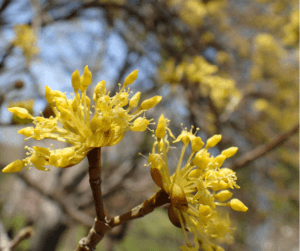
Blooming slightly earlier on similarly sized (but slightly less cold-hardy) plants is Japanese cornel, Cornus officinalis. Its early bloom time and attractively exfoliating bark mark it as arguably a superior ornamental plant to Cornus mas, but it is far less common in horticulture. As with all of the above, it is well worth searching out if, you have a place for it.

